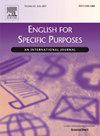Ideational interplay of textual and visual elements in graphical abstracts of biology research articles
IF 2.7
1区 文学
Q1 LINGUISTICS
引用次数: 0
Abstract
Academic journals in a wide range of disciplines are increasingly requiring graphical abstracts (GAs). A commonly noted feature of this emerging genre is the simultaneous use of textual and visual elements within a single-panel multimodal text. This dimension, however, has not been described in sufficient detail in available GA studies. To advance the discussion on textual-visual interactions in GAs, we focused on the interplay of ideational meanings created by these two distinct semiotic sources. We collected the GAs of all 129 open-access research articles published in the journal Cell throughout 2023. Using edge detection and manual checks, we decomposed these GAs into basic textual and visual units. Each basic textual unit (BTU) was paired with its visual correlates through an analytical procedure that considers both visual and semantic clues. We categorized the ideational interplay within each textual-visual pair using a framework adapted from Unsworth's (2007) taxonomy. Our findings reveal that textual elements are integral to this visually prominent genre, and the ideational textual-visual interplay exhibits several realization patterns that can serve as practical references for effective GA design. These insights may inform future research and practices in the design of graphical abstracts.
生物学研究文章图形摘要中文本和视觉元素的概念相互作用
许多学科的学术期刊对图形摘要的要求越来越高。这种新兴类型的一个普遍特点是在单面板多模态文本中同时使用文本和视觉元素。然而,在现有的遗传遗传研究中,这一维度还没有得到足够详细的描述。为了进一步探讨文本与视觉的交互作用,我们将重点放在这两种不同的符号源所产生的概念意义的相互作用上。我们收集了2023年在Cell杂志上发表的所有129篇开放获取研究论文的GAs。使用边缘检测和人工检查,我们将这些GAs分解为基本的文本和视觉单元。每个基本文本单位(BTU)通过一个考虑视觉和语义线索的分析过程与其视觉关联进行配对。我们使用Unsworth(2007)分类法改编的框架对每个文本-视觉对中的概念相互作用进行了分类。我们的研究结果表明,文本元素是这种视觉上突出的类型的组成部分,并且概念文本-视觉相互作用展示了几种实现模式,可以为有效的GA设计提供实用参考。这些见解可以为图形摘要设计的未来研究和实践提供信息。
本文章由计算机程序翻译,如有差异,请以英文原文为准。
求助全文
约1分钟内获得全文
求助全文
来源期刊

English for Specific Purposes
LINGUISTICS-
CiteScore
5.70
自引率
8.00%
发文量
41
审稿时长
62 days
期刊介绍:
English For Specific Purposes is an international peer-reviewed journal that welcomes submissions from across the world. Authors are encouraged to submit articles and research/discussion notes on topics relevant to the teaching and learning of discourse for specific communities: academic, occupational, or otherwise specialized. Topics such as the following may be treated from the perspective of English for specific purposes: second language acquisition in specialized contexts, needs assessment, curriculum development and evaluation, materials preparation, discourse analysis, descriptions of specialized varieties of English.
 求助内容:
求助内容: 应助结果提醒方式:
应助结果提醒方式:


